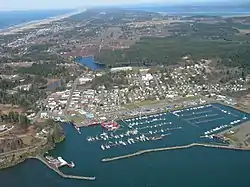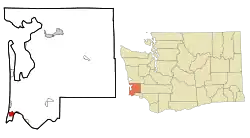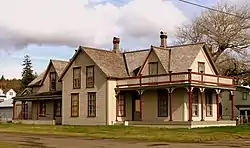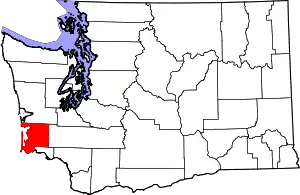Ilwaco, Washington
Ilwaco (/ɪlˈwɑːkoʊ/ il-WAH-koh) is a city in Pacific County, Washington, United States. The population was 936 at the 2010 census. Founded in 1890, the city was home to the Ilwaco Railway and Navigation Company along the Long Beach Peninsula, with its core economy based on logging and timber rafting. The city is located on the southern edge of the Long Beach Peninsula, on Baker Bay on the north side of the Columbia River where it meets the Pacific Ocean. It is near the city of Astoria, Oregon, which lies to the southeast on the southern bank of the Columbia.
Ilwaco | |
|---|---|
| Ilwaco, Washington | |
 Aerial view of Ilwaco and Ilwaco Harbor. The western edge of Long Beach Peninsula is on the left, and cranberry bogs are visible immediately north of downtown Ilwaco. | |
 Location of Ilwaco, Washington | |
| Coordinates: 46°18′45″N 124°1′47″W | |
| Country | United States |
| State | Washington |
| County | Pacific |
| Area | |
| • Total | 5.78 sq mi (14.97 km2) |
| • Land | 2.07 sq mi (5.35 km2) |
| • Water | 3.71 sq mi (9.61 km2) |
| Elevation | 23 ft (7 m) |
| Population | |
| • Total | 936 |
| • Estimate (2019)[3] | 991 |
| • Density | 479.44/sq mi (185.14/km2) |
| Time zone | UTC-8 (Pacific (PST)) |
| • Summer (DST) | UTC-7 (PDT) |
| ZIP code | 98624 |
| Area code | 360 |
| FIPS code | 53-33000[4] |
| GNIS feature ID | 1521144[5] |
| Website | City of Ilwaco |
History

Ilwaco was first settled by Henry Feister in 1851, and was named for the Lower Chinook leader Elwahko Jim, whose indigenous name was [ʔɪlwəkʷo], the son in law of Chief Comcomly.[6][7] Ilwaco was officially incorporated on December 16, 1890. A narrow gauge railway, Ilwaco Railway and Navigation Company, ran for over thirty years. Similarly to the nearby city of Astoria, Oregon, and the surrounding communities, Ilwaco historically had a significant population of Finnish immigrants.[8][9]
The railroad ran north up First Street in Ilwaco. A published photo shows the railroad's Ilwaco facilities, including a gallows turntable and elevated watering trough, were located on the southwest corner of the intersection of First and Spruce streets.[10] The depot was built nearby on Spruce Street. A siding was built for the Ilwaco Mill and Lumber Company.[11] A published photo shows the passenger depot on the west side of First Street, at a point 14.8 miles (23.8 km) from the Ilwaco Depot to Nahcotta.[12] The Ilwaco freight depot was in a different building. The freight depot survived to modern times, and has been relocated to become part of the Columbia Pacific Heritage Museum.
The train ran out on the dock in Ilwaco. Floating logs were stored behind log booms on the west side of the Ilwaco dock.[13] At some point after 1890, First Street had been covered with wooden planks, and remained so until 1916, when it was paved over.[14] By 1915, a published photo shows many more businesses along First Street.
In addition to the city's logging industry, it has had a history as a cranberry producer, with cranberry bogs located immediately north of its downtown.[15]
Geography

Ilwaco is located at 46°18′45″N 124°1′47″W (46.312541, -124.029688)[16] on the Long Beach Peninsula.
According to the United States Census Bureau, the city has a total area of 5.93 square miles (15.36 km2), of which 2.10 square miles (5.44 km2) is land and 3.83 square miles (9.92 km2) is water.[17]
Climate
This region experiences warm (but not hot) and dry summers, with no average monthly temperatures above 71.6 °F. According to the Köppen Climate Classification system, Ilwaco has a warm-summer Mediterranean climate, abbreviated "Csb" on climate maps.[18]
| Climate data for Ilwaco, Washington | |||||||||||||
|---|---|---|---|---|---|---|---|---|---|---|---|---|---|
| Month | Jan | Feb | Mar | Apr | May | Jun | Jul | Aug | Sep | Oct | Nov | Dec | Year |
| Record high °F (°C) | 65 (18) |
75 (24) |
79 (26) |
86 (30) |
94 (34) |
97 (36) |
100 (38) |
102 (39) |
99 (37) |
88 (31) |
69 (21) |
63 (17) |
102 (39) |
| Average high °F (°C) | 48.9 (9.4) |
50.7 (10.4) |
53.3 (11.8) |
56.3 (13.5) |
60.2 (15.7) |
63.5 (17.5) |
67.1 (19.5) |
68.0 (20.0) |
67.2 (19.6) |
60.1 (15.6) |
52.3 (11.3) |
47.9 (8.8) |
58.0 (14.4) |
| Average low °F (°C) | 37.4 (3.0) |
36.9 (2.7) |
38.7 (3.7) |
40.7 (4.8) |
45.4 (7.4) |
49.5 (9.7) |
52.7 (11.5) |
52.6 (11.4) |
48.8 (9.3) |
44.0 (6.7) |
39.9 (4.4) |
36.7 (2.6) |
43.6 (6.4) |
| Record low °F (°C) | 5 (−15) |
5 (−15) |
20 (−7) |
24 (−4) |
28 (−2) |
34 (1) |
37 (3) |
35 (2) |
29 (−2) |
17 (−8) |
9 (−13) |
3 (−16) |
3 (−16) |
| Average precipitation inches (mm) | 11.65 (296) |
9.89 (251) |
9.01 (229) |
5.92 (150) |
3.86 (98) |
3.05 (77) |
1.64 (42) |
1.68 (43) |
3.33 (85) |
6.83 (173) |
11.83 (300) |
12.49 (317) |
81.18 (2,061) |
| Average snowfall inches (cm) | 0.4 (1.0) |
0.6 (1.5) |
0 (0) |
0 (0) |
0 (0) |
0 (0) |
0 (0) |
0 (0) |
0 (0) |
0 (0) |
0.2 (0.51) |
0.3 (0.76) |
1.5 (3.8) |
| Source: [19][20] | |||||||||||||
Demographics
| Census | Pop. | Note | %± |
|---|---|---|---|
| 1880 | 85 | — | |
| 1890 | 517 | 508.2% | |
| 1900 | 584 | 13.0% | |
| 1910 | 664 | 13.7% | |
| 1920 | 787 | 18.5% | |
| 1930 | 750 | −4.7% | |
| 1940 | 656 | −12.5% | |
| 1950 | 628 | −4.3% | |
| 1960 | 518 | −17.5% | |
| 1970 | 506 | −2.3% | |
| 1980 | 604 | 19.4% | |
| 1990 | 815 | 34.9% | |
| 2000 | 950 | 16.6% | |
| 2010 | 936 | −1.5% | |
| 2019 (est.) | 991 | [3] | 5.9% |
| U.S. Decennial Census[21] | |||
2010 census
As of the census[2] of 2010, there were 936 people, 443 households, and 257 families living in the city. The population density was 445.7 inhabitants per square mile (172.1/km2). There were 567 housing units at an average density of 270.0 per square mile (104.2/km2). The racial makeup of the city was 89.9% White, 0.3% African American, 2.1% Native American, 0.5% Asian, 3.6% from other races, and 3.5% from two or more races. Hispanic or Latino of any race were 5.7% of the population.
There were 443 households, of which 21.2% had children under the age of 18 living with them, 46.7% were married couples living together, 8.4% had a female householder with no husband present, 2.9% had a male householder with no wife present, and 42.0% were non-families. 35.7% of all households were made up of individuals, and 13.7% had someone living alone who was 65 years of age or older. The average household size was 2.11 and the average family size was 2.68.
The median age in the city was 50.2 years. 16.7% of residents were under the age of 18; 5.2% were between the ages of 18 and 24; 21.2% were from 25 to 44; 35.3% were from 45 to 64; and 21.6% were 65 years of age or older. The gender makeup of the city was 51.5% male and 48.5% female.
2000 census
As of the census[4] of 2000, there were 950 people, 416 households, and 260 families living in the city. The population density was 461.5 people per square mile (178.1/km2). There were 524 housing units at an average density of 254.6 per square mile (98.2/km2). The racial makeup of the city was 92.84% White, 0.53% African American, 1.37% Native American, 0.42% Asian, 0.11% Pacific Islander, 1.79% from other races, and 2.95% from two or more races. Hispanic or Latino of any race were 5.26% of the population. 15.9% were of German, 13.6% Finnish, 10.1% English, 5.8% American, 5.2% Swedish and 5.1% Norwegian ancestry according to Census 2000.
There were 416 households, out of which 27.2% had children under the age of 18 living with them, 52.4% were married couples living together, 8.7% had a female householder with no husband present, and 37.5% were non-families. 33.4% of all households were made up of individuals, and 16.6% had someone living alone who was 65 years of age or older. The average household size was 2.28 and the average family size was 2.92.
In the city, the population was spread out, with 24.2% under the age of 18, 4.9% from 18 to 24, 23.6% from 25 to 44, 27.3% from 45 to 64, and 20.0% who were 65 years of age or older. The median age was 43 years. For every 100 females, there were 90.4 males. For every 100 females age 18 and over, there were 83.2 males.
The median income for a household in the city was $29,632, and the median income for a family was $34,934. Males had a median income of $29,821 versus $21,442 for females. The per capita income for the city was $16,138. About 10.3% of families and 16.3% of the population were below the poverty line, including 21.1% of those under age 18 and 16.3% of those age 65 or over.
References
- "2019 U.S. Gazetteer Files". United States Census Bureau. Retrieved August 7, 2020.
- "U.S. Census website". United States Census Bureau. Retrieved December 19, 2012.
- "Annual Estimates of the Resident Population for Incorporated Places in Washington: April 1, 2010 to July 1, 2019". United States Census Bureau. May 2020. Retrieved May 27, 2020.
- "U.S. Census website". United States Census Bureau. Retrieved January 31, 2008.
- "Ilwaco". Geographic Names Information System. United States Geological Survey, United States Department of the Interior.
- Majors, Harry M. (1975). Exploring Washington. Van Winkle Publishing Co. p. 114. ISBN 978-0-918664-00-6.
- Bright, William (2004). Native American Placenames of the United States. University of Oklahoma Press. p. 181. Retrieved January 29, 2023.
- Samuels, Charles (1962). The King, A Biography of Clark Gable. Coward-McCann. p. 73.
- White, Sid; Solberg, Sammy Edward (1989). Peoples of Washington: Perspectives on Cultural Diversity. Washington State University Press. p. 46. ISBN 978-0-874-22062-9.
- Feagans 1972, p. 28.
- Feagans 1972, p. 37.
- Feagans 1972, p. 78.
- Feagans 1972, pp. 33, 52.
- Feagans 1972, p. 81.
- "Northwest's cranberry bogs have their season of glory". The Seattle Times. Associated Press. November 22, 2016. Retrieved December 15, 2017.
- "US Gazetteer files: 2010, 2000, and 1990". United States Census Bureau. February 12, 2011. Retrieved April 23, 2011.
- "US Gazetteer files 2010". United States Census Bureau. Archived from the original on January 12, 2012. Retrieved December 19, 2012.
- Climate Summary for Ilwaco, Washington
- "Zipcode 98624". www.plantmaps.com. Retrieved May 12, 2023.
- "Climate in Ilwaco, Washington". www.bestplaces.net. Retrieved May 12, 2023.
- United States Census Bureau. "Census of Population and Housing". Retrieved September 8, 2014.
Works cited
- Feagans, Raymond (1972). The Railroad that Ran by the Tide: Ilwaco Railroad & Navigation Co. of the State of Washington. Howell-North Books. ISBN 978-0-831-07094-6.
External links
- History of Ilwaco at HistoryLink
- Ilwaco Washington: By Land or Sea Archived March 8, 2005, at the Wayback Machine
- Ilwaco in 1897
- B.A. Seaborg Cannery, Ilwaco, 1897
- Modern view of First Street in Ilwaco, looking north. The railroad would have run past some of the older buildings in this photograph
- Modern view of fishing fleet at Ilwaco
